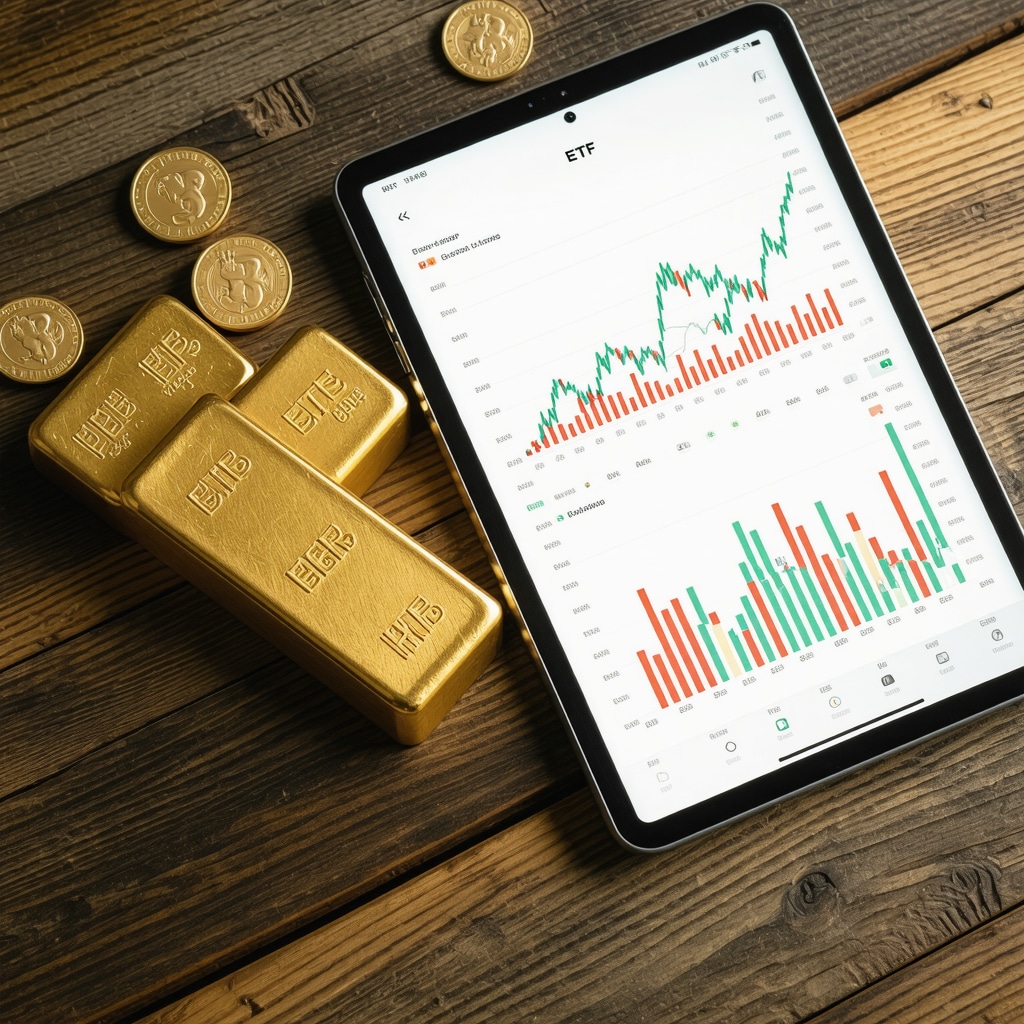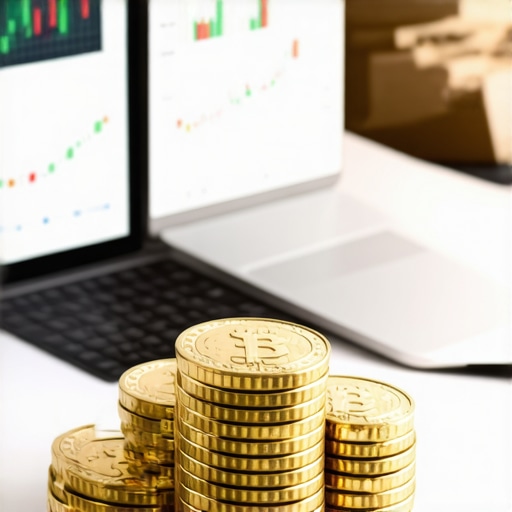Unveiling the Timeless Appeal: Why Compare Physical Gold and ETFs?
When it comes to diversifying your portfolio or hedging against inflation, gold remains a perennial favorite. Yet, investors today face a critical decision: should they hold physical gold or opt for gold-backed Exchange-Traded Funds (ETFs)? This question isn’t merely academic—each option embodies distinct advantages and challenges that can profoundly impact your wealth preservation and growth strategy in 2029’s dynamic financial landscape.
Feel the Weight or Trust the Digital Ledger? A Deeper Look at Physical Gold
Physical gold, manifesting as bullion bars or coins, offers tangible security. Holding gold in your hand can provide psychological comfort that no digital asset can replicate. Beyond sentiment, physical gold serves as a direct store of value immune to counterparty risk, making it a steadfast refuge during market turmoil. However, ownership isn’t without complexities: storage costs, insurance, and potential liquidity constraints require thoughtful management. For example, investors who purchased gold bars during geopolitical uncertainty in early 2020 experienced not just price appreciation but also the reassurance of a physical asset shielded from digital market outages.
Gold ETFs: The Liquid Gateway to Precious Metal Exposure
Gold ETFs democratize access to gold investing by allowing fractional ownership without the hassles of physical custody. They trade like stocks, providing liquidity and ease of transaction that physical gold cannot match. This makes ETFs especially attractive for active traders or those seeking portfolio flexibility. However, ETFs introduce counterparty risk; while most are backed by allocated physical gold stored by custodians, the investor does not possess the metal directly. Additionally, management fees can subtly erode returns over time. A savvy investor might balance these factors by incorporating ETFs for exposure but complementing them with a core holding of physical gold.
How Do Investors Decide Between Physical Gold and ETFs for Their Goals?
The decision pivots on individual investment objectives, risk tolerance, and time horizon. Those prioritizing security and control may gravitate toward physical gold, especially for long-term wealth preservation or estate planning. Conversely, investors seeking agility, lower entry thresholds, and cost efficiency might prefer gold ETFs. Moreover, geopolitical climates, inflation outlooks, and portfolio diversification needs should inform this choice. Engaging with authoritative analyses, such as the comprehensive guide on physical gold versus ETFs, can illuminate nuanced considerations and emerging trends shaping these investment vehicles.
The Dual Approach: Combining Physical Gold and ETFs for Strategic Balance
Many seasoned investors adopt a hybrid strategy, leveraging the liquidity and convenience of ETFs while anchoring their portfolio with physical gold’s tangible security. This blend can optimize both growth potential and risk mitigation. For instance, during volatile market phases, the physical asset provides a hedge against systemic risks, while ETFs allow swift reallocation as market conditions evolve. Such a strategy demands continuous market awareness and disciplined portfolio reviews to maintain the desired balance.
If you found these insights helpful, consider sharing this article with fellow investors or leaving a comment with your own experiences and strategies to foster a community of informed decision-making.
For further reading on safe acquisition and storage of physical gold, check out our physical gold investment strategies guide.
Source: World Gold Council – Gold Investment Facts and Figures
The Emotional Connection: Why Holding Physical Gold Feels Different
Reflecting on my own journey with gold investing, I recall the distinct feeling of holding a gold coin for the first time. There’s an undeniable emotional resonance—a tactile link to history and value—that simply can’t be replicated by digital shares of an ETF. This physical connection often translates to a stronger conviction during turbulent markets, where the intangible nature of ETFs might feel less reassuring.
Yet, I’ve noticed how this emotional comfort comes paired with practical considerations. Storing physical gold safely demands space, security measures, and sometimes, third-party vault services. Each option carries costs and trust implications. Having personally navigated these logistics, I can attest that understanding your storage options is as crucial as the purchase itself. For those interested, the quick tips for safe gold bullion storage provide an excellent starting point.
Liquidity and Flexibility: The Compelling Case for Gold ETFs
On the flip side, my experience with gold ETFs has highlighted their unmatched convenience. Trading ETFs is seamless—no concerns about shipping or verifying authenticity. In fast-moving markets, this liquidity can be a game-changer, allowing quick portfolio adjustments. However, this ease isn’t without trade-offs. ETFs involve management fees that accumulate over time, subtly impacting returns. Plus, the investor’s exposure depends on the custodian’s integrity and regulatory frameworks, which, while generally robust, introduce a different kind of risk compared to physical ownership.
How Do You Decide Which Gold Investment Fits Your Lifestyle and Goals?
This question has often occupied my thoughts and conversations with fellow investors. The choice boils down to your personal financial objectives, risk tolerance, and lifestyle preferences. Are you looking for a long-term hedge, perhaps for retirement or legacy planning? Physical gold might serve you better. Or do you prioritize ease of access and the ability to respond swiftly to market changes? ETFs could be more suitable. Exploring comprehensive resources like the types of gold investments can provide deeper clarity.
Balancing Act: Crafting a Personalized Gold Investment Strategy
For me, the sweet spot has been blending both worlds. Allocating a portion of my portfolio to physical gold satisfies my need for tangible security, while ETFs provide the agility to capitalize on market trends. This balanced approach requires ongoing diligence—regularly reviewing allocations, staying informed about market dynamics, and adjusting based on changing personal circumstances and economic signals.
Speaking of staying informed, the World Gold Council offers invaluable data and analysis that have helped me navigate these choices with confidence.
Have you experimented with physical gold, ETFs, or a combination of both? What’s your experience been like balancing these options? I’d love to hear your stories and insights in the comments below—sharing our journeys can enrich everyone’s understanding and decision-making.
Refined Portfolio Dynamics: Leveraging Market Cycles Through Gold Investment Synergies
In the ever-evolving 2029 financial ecosystem, mastering the interplay between physical gold and gold ETFs requires not only understanding their individual merits but also how they interact across different market cycles. Investors who appreciate the nuanced timing of asset allocation shifts can harness this synergy to optimize returns and minimize risks. For instance, during periods of heightened geopolitical tension or systemic financial uncertainty, physical gold’s intrinsic value and independence from digital infrastructures become paramount. Conversely, in stable or bullish equity markets, gold ETFs offer nimbleness, enabling rapid portfolio rebalancing to capitalize on emerging opportunities or hedge against sudden price corrections.
Such dynamic reallocation strategies demand vigilance and expertise, often leveraging quantitative models that incorporate volatility indices, inflation expectations, and monetary policy signals. Tools like the Investopedia analysis on gold ETF mechanics provide foundational insights, but advanced investors often delve deeper into econometric data to forecast gold’s correlation with other asset classes over varying time horizons.
How Can Sophisticated Investors Mitigate Counterparty and Custodial Risks in Gold ETFs?
While the convenience of gold ETFs is undeniable, expert investors recognize that the embedded counterparty risk necessitates rigorous due diligence. This involves evaluating the custodian’s reputation, regulatory oversight, and transparency in reporting physical gold reserves backing the ETF. Some ETFs maintain fully allocated gold, while others use pooled or unallocated holdings, impacting the security of your investment.
To mitigate these risks, diversification across multiple ETFs and integrating allocated physical gold held in trusted vaults can provide a robust safety net. Additionally, understanding the legal frameworks governing custodianship and redemption rights is crucial, as highlighted by the U.S. Securities and Exchange Commission’s ETF investor bulletin. Such scrutiny ensures that your portfolio remains resilient against operational failures or market disruptions.
Optimizing Tax Efficiency: Strategic Considerations for Gold Holdings
Tax implications often shape the net performance of gold investments, yet they are frequently overlooked. Physical gold is typically treated as a collectible in many jurisdictions, subjecting gains to higher capital gains tax rates. In contrast, gold ETFs may be taxed as securities, often benefiting from more favorable long-term capital gains treatment. This divergence necessitates a tailored approach aligned with your tax residency and investment horizon.
Advanced investors collaborate with tax professionals to structure holdings and transactions that optimize after-tax returns. Techniques such as strategic timing of disposals, using tax-advantaged accounts for ETFs, or employing physical gold trusts can significantly influence portfolio efficiency. The IRS Topic No. 409 on Collectibles Tax offers authoritative guidance on U.S. tax treatment, serving as a reference point for understanding these complexities.
Enhancing Portfolio Resilience: The Role of Physical Gold in Crisis Scenarios
Beyond conventional financial metrics, physical gold plays a critical role in scenarios where digital infrastructures falter—be it due to cyberattacks, banking system failures, or extreme regulatory clampdowns. Its universal acceptance and intrinsic value make it an unparalleled asset for preserving liquidity and purchasing power when traditional systems are compromised.
Establishing secure, accessible storage solutions—such as private vaults or insured deposit boxes—forms part of a comprehensive crisis preparedness strategy. Investors often complement this with contingency plans that include pre-arranged redemption pathways or barter mechanisms, reinforcing gold’s function as a last-resort financial safeguard.

What Are the Emerging Innovations in Physical Gold Custody and Blockchain Integration?
Recent advances are blending tradition with technology, as blockchain-enabled platforms facilitate proof of ownership and fractionalized access to physical gold holdings. These innovations aim to enhance transparency, reduce counterparty risk, and improve liquidity without surrendering the security of owning tangible assets.
For example, tokenized gold platforms allow investors to hold digital certificates backed by physically allocated gold stored in audited vaults, combining the best attributes of physical and ETF investments. However, regulatory frameworks continue to evolve, and investors must remain cautious and well-informed before embracing these cutting-edge solutions.
To deepen your understanding of these sophisticated strategies and their practical implementation, consider engaging with expert webinars and industry whitepapers available from the World Gold Council’s research hub. These resources provide actionable insights and data-driven analysis tailored for the discerning investor.
Innovative Custodial Solutions: Blockchain and Tokenization Transforming Physical Gold Ownership
As the gold investment landscape evolves, pioneering custodial mechanisms are reshaping how investors access and secure physical gold. Blockchain technology, in particular, introduces immutable ledgers that verify ownership, enhance transparency, and mitigate traditional counterparty risks. Tokenized gold platforms enable fractionalized ownership, allowing investors to hold digital assets backed by physical bullion stored in audited vaults worldwide. This fusion of tangible asset security with digital liquidity empowers sophisticated investors to diversify access methods without compromising the intrinsic value of physical gold.
However, regulatory oversight is still catching up with these advancements, necessitating meticulous due diligence and an understanding of jurisdictional nuances before committing capital. Industry leaders like the World Gold Council’s report on gold tokenization provide comprehensive analyses on the risks and rewards of such innovations.
Mastering Tax Efficiency: Structuring Gold Investments to Maximize After-Tax Returns
Tax optimization remains a pivotal factor in enhancing net portfolio performance. The disparate tax treatment of physical gold versus ETFs demands strategic structuring, especially for investors operating across multiple tax jurisdictions. Physical gold, often classified as a collectible, can incur elevated capital gains taxes, whereas ETFs may benefit from more favorable long-term capital gains rates or tax-deferred growth within retirement accounts.
Advanced strategies include utilizing tax-advantaged accounts for ETF holdings, employing physical gold trusts, or timing disposals to coincide with lower tax brackets. Collaboration with seasoned tax advisors ensures alignment with evolving tax codes and leverages opportunities such as tax-loss harvesting. For detailed guidance, consult resources like the IRS Topic No. 409 on Collectibles Tax, which offers authoritative U.S. tax perspectives.
Strategic Crisis Preparedness: Elevating Physical Gold’s Role in Portfolio Resilience
In an era marked by technological vulnerabilities and geopolitical uncertainties, physical gold’s role transcends conventional investment metrics. It acts as a critical contingency asset during systemic disruptions such as cyberattacks, banking collapses, or stringent capital controls. Establishing secure and accessible storage solutions—ranging from private insured vaults to geographically diversified depositories—fortifies this resilience.
Investors should also develop comprehensive crisis response plans, including pre-negotiated redemption options and understanding barter dynamics in disrupted economies. Such preparedness not only preserves purchasing power but also maintains liquidity when traditional financial instruments falter.

What Are the Best Practices to Integrate Emerging Custody Technologies While Mitigating Associated Risks?
Integrating cutting-edge custody innovations requires a balanced approach. Investors should rigorously evaluate platform transparency, regulatory compliance, and the auditability of gold reserves backing digital tokens. Diversifying custody solutions—combining traditional allocated gold holdings with tokenized assets—can mitigate systemic risks inherent in nascent technologies.
Continuous education through reputable sources and participation in expert forums is essential. The World Gold Council’s research hub offers invaluable resources detailing technological trends, regulatory developments, and risk management frameworks to guide informed decision-making.
Engage with these advanced insights to refine your gold investment strategy and future-proof your portfolio against evolving market and technological landscapes. Share your experiences or questions in the comments to join a community of expert investors navigating the gold frontier.
Frequently Asked Questions (FAQ)
What are the main differences between physical gold and gold ETFs in terms of ownership?
Physical gold means direct possession of tangible bullion or coins, providing inherent control and security without counterparty risk. Gold ETFs represent shares in a fund that holds gold assets; investors own units but not the physical metal itself, introducing some custodial and counterparty risk despite generally high regulatory oversight.
How does liquidity compare between physical gold and gold ETFs?
Gold ETFs offer superior liquidity, trading on exchanges like stocks with instant price discovery and ease of buying or selling. Physical gold can be less liquid due to verification, shipping, and potential market premiums, although it remains universally accepted during crises.
What are the cost implications of investing in physical gold versus gold ETFs?
Physical gold incurs upfront premiums, storage fees, insurance, and potential transaction costs. Gold ETFs typically involve management fees and brokerage commissions but avoid physical custody expenses, making them generally more cost-efficient for smaller or more active investors.
How do tax treatments differ between physical gold and gold ETFs?
Tax treatment varies by jurisdiction, but physical gold often is classified as a collectible with higher capital gains tax rates, while gold ETFs may be taxed as securities with more favorable long-term capital gains rates. Consulting tax professionals and local regulations is essential to optimize after-tax returns.
Can I use physical gold as a hedge during financial crises?
Yes. Physical gold is prized for its intrinsic value and independence from financial systems, making it a reliable store of wealth during systemic crises, cyberattacks, or banking failures where digital assets or ETFs may face operational risks.
What risks are associated with gold ETFs and how can they be mitigated?
Key risks include counterparty risk, custodian insolvency, and regulatory changes. Mitigation strategies involve selecting ETFs with fully allocated gold, diversifying across multiple funds, and complementing holdings with physical gold to reduce exposure to operational failures.
How do blockchain and tokenization impact physical gold ownership?
Blockchain-enabled tokenization allows fractional ownership and enhanced transparency by recording ownership on immutable ledgers, combining physical gold security with digital liquidity. However, regulatory frameworks are evolving, and investors must perform thorough due diligence before participation.
Is a blended strategy of physical gold and ETFs advisable?
Yes. Combining physical gold’s security with ETFs’ liquidity and flexibility can optimize portfolio resilience and responsiveness. This requires ongoing portfolio review and alignment with investment goals and market conditions.
What storage options exist for physical gold, and what should investors consider?
Storage options include private home safes, insured third-party vaults, and geographically diversified depositories. Consider security, insurance, accessibility, and cost when choosing the optimal storage method aligned with your risk tolerance and crisis preparedness.
How can investors stay informed about gold investment innovations and regulatory changes?
Engaging with reputable research hubs like the World Gold Council, attending expert webinars, and consulting industry whitepapers help investors remain current on technological advances, tax regulations, and market trends impacting gold investments.
Trusted External Sources
- World Gold Council (https://www.gold.org) – The premier authority on gold market data, investment research, and industry trends, providing comprehensive analyses on gold’s role in portfolios and innovations like tokenization.
- U.S. Securities and Exchange Commission (https://www.sec.gov/investor/pubs/etfs.htm) – Offers investor bulletins detailing ETF structures, risks, and regulations, essential for understanding counterparty and custodial considerations in gold ETFs.
- Investopedia (https://www.investopedia.com/terms/g/gold-etf.asp) – Provides foundational insights into gold ETF mechanics, taxation, and trading strategies, helping investors grasp the nuances of ETF investments.
- IRS Topic No. 409 on Collectibles Tax (https://www.irs.gov/taxtopics/tc409) – Authoritative guidance on U.S. tax treatment of physical gold as collectibles, crucial for tax planning and compliance.
- World Gold Council’s Research Hub (https://www.gold.org/goldhub/research) – A repository of in-depth reports, whitepapers, and data-driven insights into gold investment strategies, custody innovations, and market dynamics.
Conclusion
Choosing between physical gold and gold ETFs in 2029 demands a sophisticated understanding of their distinct characteristics, market behaviors, and evolving technological landscapes. Physical gold offers unmatched tangibility, crisis resilience, and psychological assurance, albeit with storage and liquidity considerations. Conversely, gold ETFs provide fluid market access, cost efficiency, and portfolio flexibility but carry embedded counterparty and regulatory risks.
A nuanced, hybrid approach that strategically blends both investment vehicles can harness their complementary strengths—anchoring portfolios with physical metal’s security while leveraging ETFs’ agility to navigate market cycles. Attentive tax planning and embracing emerging custody innovations like blockchain tokenization further refine this strategy, optimizing after-tax returns and future-proofing holdings.
By integrating expert insights, rigorous due diligence, and continuous education, investors can confidently tailor gold investments to their unique financial objectives and risk profiles. We invite you to apply these advanced perspectives to your portfolio, share your experiences, and explore related expert content to deepen your mastery of gold investing in today’s complex financial environment.










